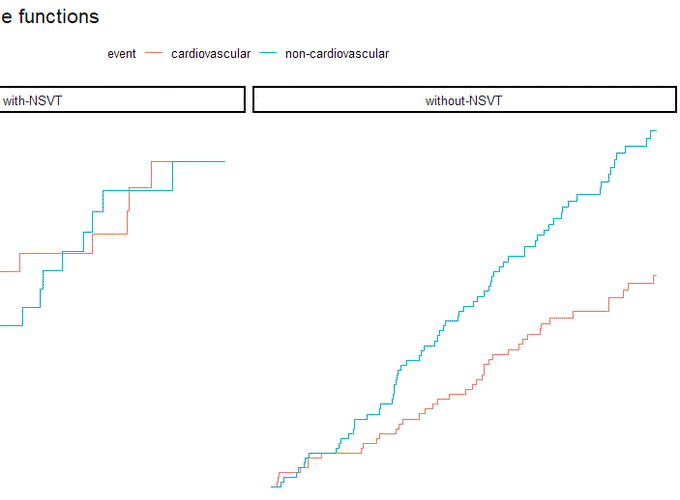 Cumulative Incidence Functions for cardiovascular (red) and non-cardiovascular (blue) death in the group with Non-Sustained Ventricular Tachycardia (NSVT) - on the left – and without NSVT during the first year of follow-up – on the right.
Cumulative Incidence Functions for cardiovascular (red) and non-cardiovascular (blue) death in the group with Non-Sustained Ventricular Tachycardia (NSVT) - on the left – and without NSVT during the first year of follow-up – on the right.
Prognostic role of non-sustained ventricular tachycardia detected with remote interrogation in a pacemaker population
Abstract
Background: Non-sustained ventricular tachycardia (NSVT) can occur asymptomatically and can be incidentally detected in the internal records of pacemakers (PM). The clinical value of NSVT in the population of PM patients is still uncertain. Our aim was to assess the prevalence of NSVT detected by remote PM control, to describe the clinical and demographic characteristics of patients with NSVT, and to assess the prognostic significance of NSVT in terms of both overall and cardiovascular mortality. Methods: Consecutive patients followedwith PMremote interrogations fromSeptember 2010 to December 2015 were included. The transmissions pertaining to the first 12 months of remote control were analysed and the patients were divided by those presenting NSVT and those without NSVT. The two groups were compared in terms of total mortality and cardiovascular mortality based on the administrative data provided by the regional administration of the Italian National Health System. Results: The prevalence of NSVT in 408 patients (62% males, mean age 75.6; SD 10.6 years old) was 21% in a year. During a mean follow-up duration of 44 months, NSVT did not emerge as independently associated with overall mortality, butwas associated with cardiovascular mortality in a competing risk regressionmodelwith older age, male gender, diabetes, chronic renal insufficiency, ischemic cardiomyopathy and chronic obstructive pulmonary disease. Conclusions: We show that NSVT episodes recorded by remote control in a PM population are independently associated with cardiovascular mortality with possible implications for risk stratification and therapeutic options.